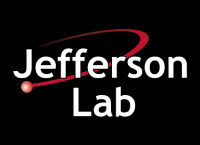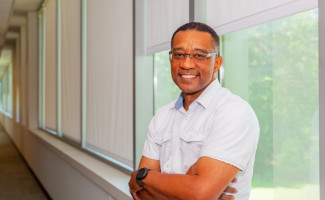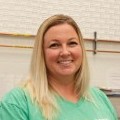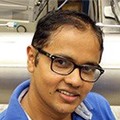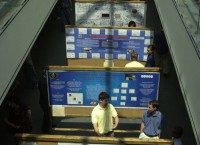Mechanical designer uses expertise to craft equipment that enables cutting-edge experiments.
Modeling and Design Critical to Project Success
When Ron Lassiter walks into Halls A, B and C at Jefferson Lab, he has a sense of pride and fascination—feelings that come from being the mechanical designer of many of the machines and parts that make the lab run.
Lassiter’s work largely takes place on a computer, where he translates scientists’ project requirements and goals into 2-dimensional and 3-dimensional models of equipment that he thinks will enable the experiments to function. The work—and results—are fulfilling to Lassiter.
“Seeing the end result, it fascinates me,” he said. “Here at the lab you get to see what you’ve worked on. You can hold it in your hands. It’s rewarding to know that you’ve played a part in helping the machine to be successful.”
Understanding Machines and How to Use Them
One might assume that Lassiter must have a scientific background in order to understand and fulfill equipment deliverables for very specific and high-level experiments. However, Lassiter says he has to have some of the general ideas behind the science, such as how the machines work, the operating temperatures and materials, along with a host of software he may need to call upon for specific design capabilities, including NX, Fusion 360, AutoCAD and Inventor.
“I don’t understand all of the physics behind all of the experiments, but my job is to make sure that our design offers what the scientists are looking for—the end product,” Lassiter explained. “I know how to build models and to stay within the confinement of where the experiment is going. For example, when a project requires a certain beam direction, I know how to position my model so it takes into account the direction of the beam. I also know what materials can and cannot be used.”
Lassiter admits that much of his current work as a mechanical designer is based on existing infrastructure, some of which was put into place before he began his tenure at the lab in 2000.
“Each hall has basically already been laid out by previous designers and engineers and we are building upon what’s been done in the past,” he said. “There are some things that are challenges that call us to have to be creative with what we’re thinking. For example, right now we’re doing some fine-tuning on the cryomodules so that all previous changes to the equipment are incorporated into new drawings.”
The process of integrating existing infrastructure into new designs can be painstaking, according to Lassiter. For example, there are thousands of magnets installed at Jefferson Lab, and each one must be labeled individually so that models perfectly sync with infrastructure throughout the lab. For help with this intricate work, Lassiter has a student assistant from Thomas Nelson Community College whom he has trained on the lab’s design software. Once the labels are all in place, designing will be more fluid.
Design, Refine and Build
Just as each experiment is unique, each physicist has his or her own way of communicating their project needs to Lassiter.
“Sometimes they have drawings and sometimes they sketch on a board what they are looking for and it’s just a sketch because they don’t know exactly what they need,” he said. “I listen to what they say and come up with a sketch that I present to them.”
After presenting his initial sketch to the project lead, Lassiter may refine the 2-D sketch multiple times until he creates a 3-D model of the machine or equipment, which he then presents to the team. From the final model, the engineering team can begin crafting the machine or equipment and the experiment can move forward.
Because his role is so critical to enabling scientific experiments to move forward, Lassiter must be confident in his ability to combine his design and software skills with his aptitude for logistics. For that, he is appreciative of the education and responsibility provided to him by his early years as a construction and machine designer the Newport News shipyard, where he first learned how to use design software for large projects.
“I always wanted to create things,” said Lassiter. “I love building things, coming up with conceptions and seeing the end result.”
By Carrie Rogers


